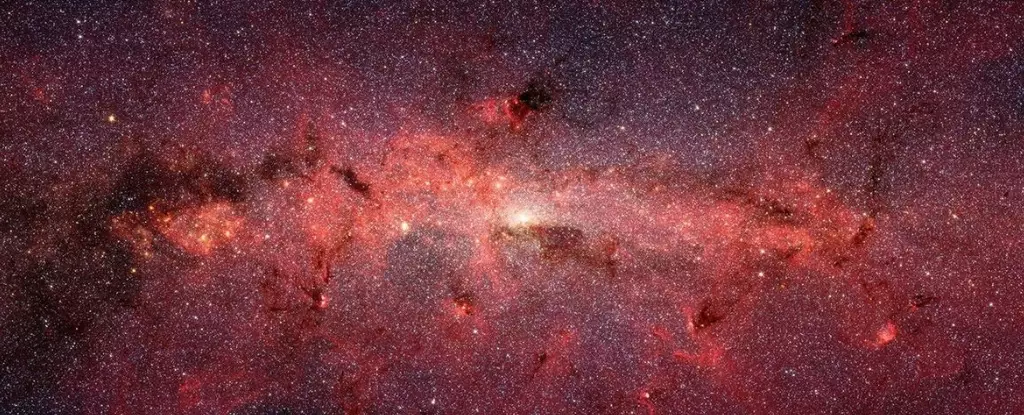The Milky Way, a beautiful spiral galaxy teeming with secrets, harbors enigmas that baffle even the most skilled astronomers. At the heart of these mysteries lies the central molecular zone (CMZ), a tumultuous area densely packed with gas. This region is not just a passive player in our galaxy but a vibrant zone of activity, where gas is astonishingly ionized at an unexpected rate. Furthermore, an enigmatic emission of gamma rays at 511 kilo-electronvolts (keV) emerges from this very zone, hinting at celestial processes that defy traditional comprehension.
The CMZ, spanning approximately 700 light-years, contains some of the galaxy’s most concentrated molecular gas. It operates almost like a smorgasbord of gases, star formations, and complex interactions. Yet, even with modern advancements in astrophysics, the causes behind the unusual levels of ionization and gamma-ray emissions remain elusive. Researchers have speculated about various sources, from cosmic rays to nearby black holes, but none fully encapsulate the phenomena’s enigmatic essence.
Seeking the Source: Can Dark Matter Illuminate the Unknown?
Dark matter, an invisible force constituting around 85% of the universe’s matter, could hold the key to these cosmic questions. Although we cannot observe dark matter directly because it neither emits nor absorbs light, its effects on gravitational forces are evident. Herein lies a less frequently discussed possibility: the existence of light dark matter particles, known as sub-GeV dark matter, which could have substantial implications for our understanding of cosmic dynamics.
This proposition raises tantalizing questions. What if these light dark matter particles can interact with their antiparticles? If such interactions occur in the galactic core, annihilating each other and generating electrons and positrons, the implications could be profound. The electrons born from this annihilation process would penetrate the dense hydrogen molecules of the CMZ, creating an ionization rate that aligns perfectly with observed data. Imagine a cosmic ballet where abstract particles are the dancers, their movements choreographed by the invisible forces of dark matter.
The Remarkable Link Between Ionization and Gamma Rays
The tantalizing prospect that dark matter could be responsible for both the ionization of the CMZ and the generation of gamma rays could potentially reshape our understanding of fundamental astrophysical processes. Researchers conducted simulations suggesting that when light dark matter meets its antiparticles, electrons and positrons are produced, leading to increased electron interactions in the surrounding gas. This interaction means that dark matter may not only serve as the fabled ‘missing link’ in cosmic evolution but also be a catalyst for the interesting phenomena occurring in our galactic backyard.
Furthermore, as positrons slow down and annihilate with electrons, they release energy in the form of gamma rays at the 511 keV mark. This connection suggests that both the ionization observed in the CMZ and the mysterious gamma-ray background could emanate from the same astrophysical source: light dark matter. However, navigating the complexities of particle behavior is rife with uncertainty, and the research community acknowledges that more fine-tuning and observation is needed.
Cosmic Observations: A New Lens on the Nature of Dark Matter
The implications of linking ionization rates in the CMZ to dark matter are monumental. It provides a new perspective that facilitates the testing of models concerning light dark matter particles. Traditionally, experiments aimed at isolating dark matter have encountered significant difficulties, but astrophysical phenomena like those observed in the CMZ serve as natural laboratories where dark matter may reveal its properties.
Interestingly, the observed ionization is uniformly spread across the CMZ, a pattern that is at odds with localized sources such as nearby supernovae or the central black hole. Such even distribution aligns well with theories proposing a smoothly distributed dark matter halo. As new telescopes bring enhanced resolution and sensitivity, they have the potential to paint a more vivid picture of the spatial dynamics between the 511 keV emissions and CMZ ionization rates.
Whether or not dark matter ultimately explains the CMZ phenomena, the implications of such theories extend beyond a singular anomaly. They invite us to participate in an ongoing dialogue about the cosmos and its underlying mysteries. Our position within the Milky Way reminds us that we are, in a sense, both participants in and observers of a dynamic universe. As the field of astrophysics evolves, who knows what further cosmic revelations await us? The heart of our galaxy may one day serve as the beacon illuminating a path to understanding the darkest aspects of our universe, emboldening humanity’s quest for knowledge and connection with the cosmos.


Leave a Reply